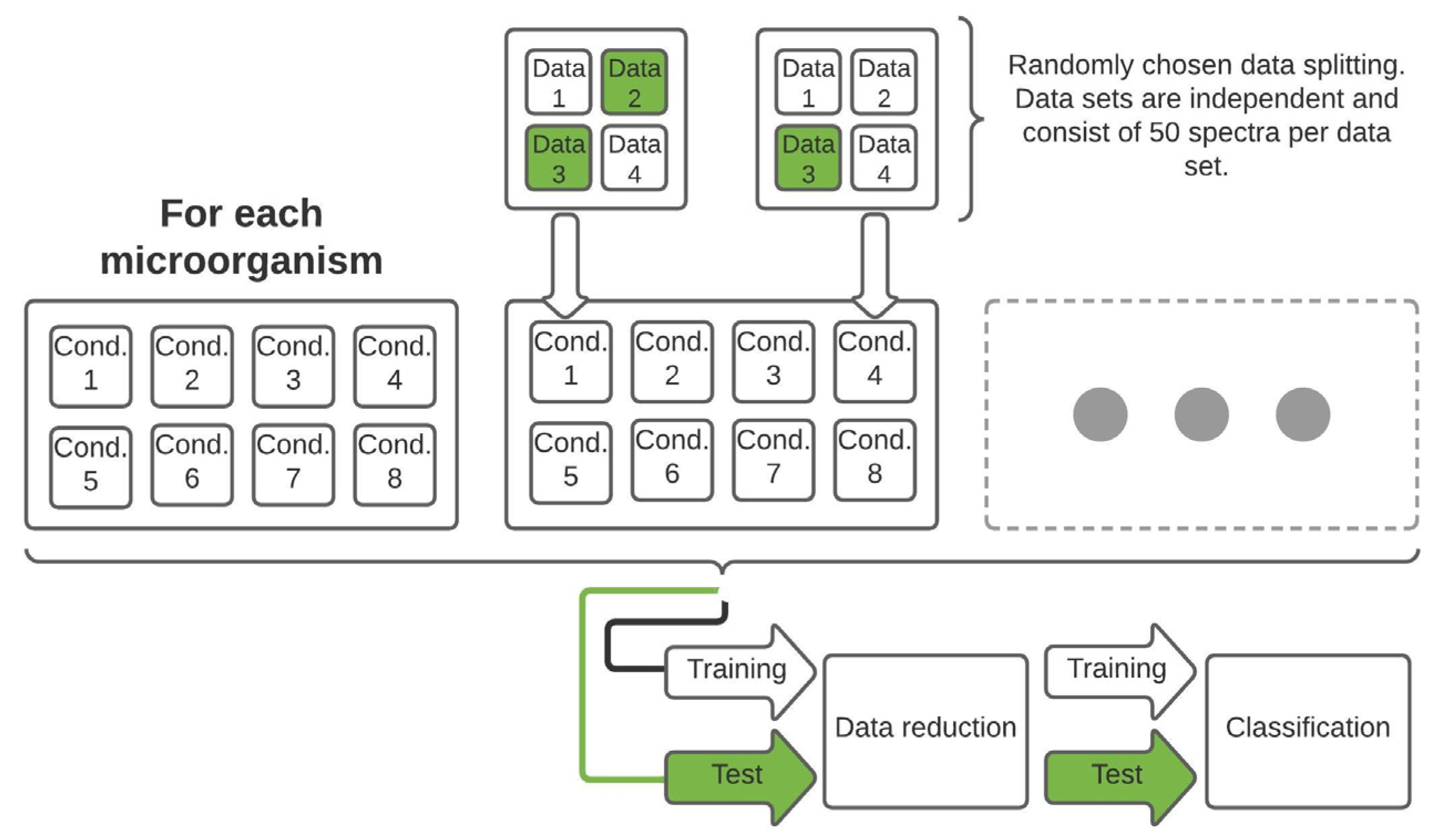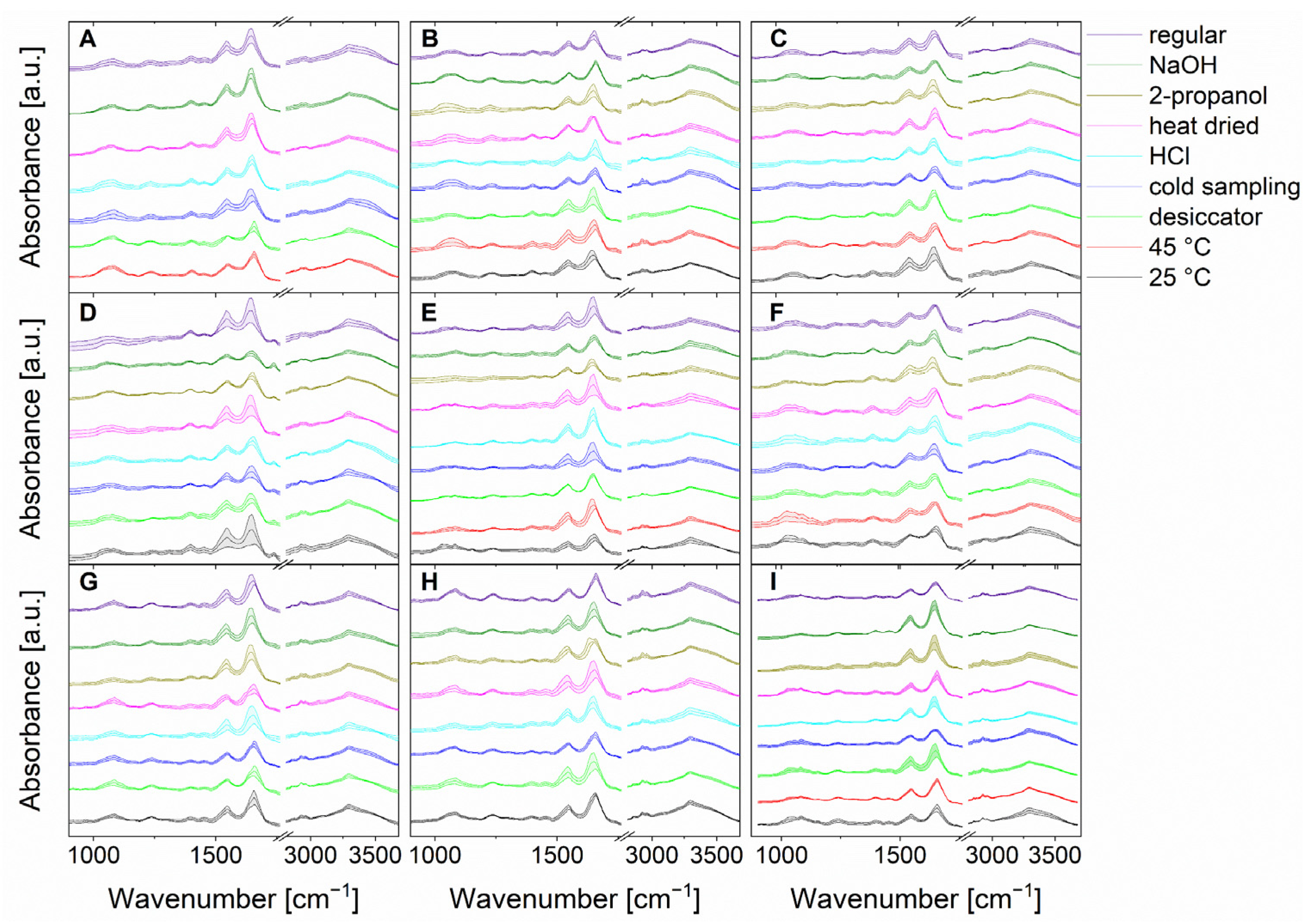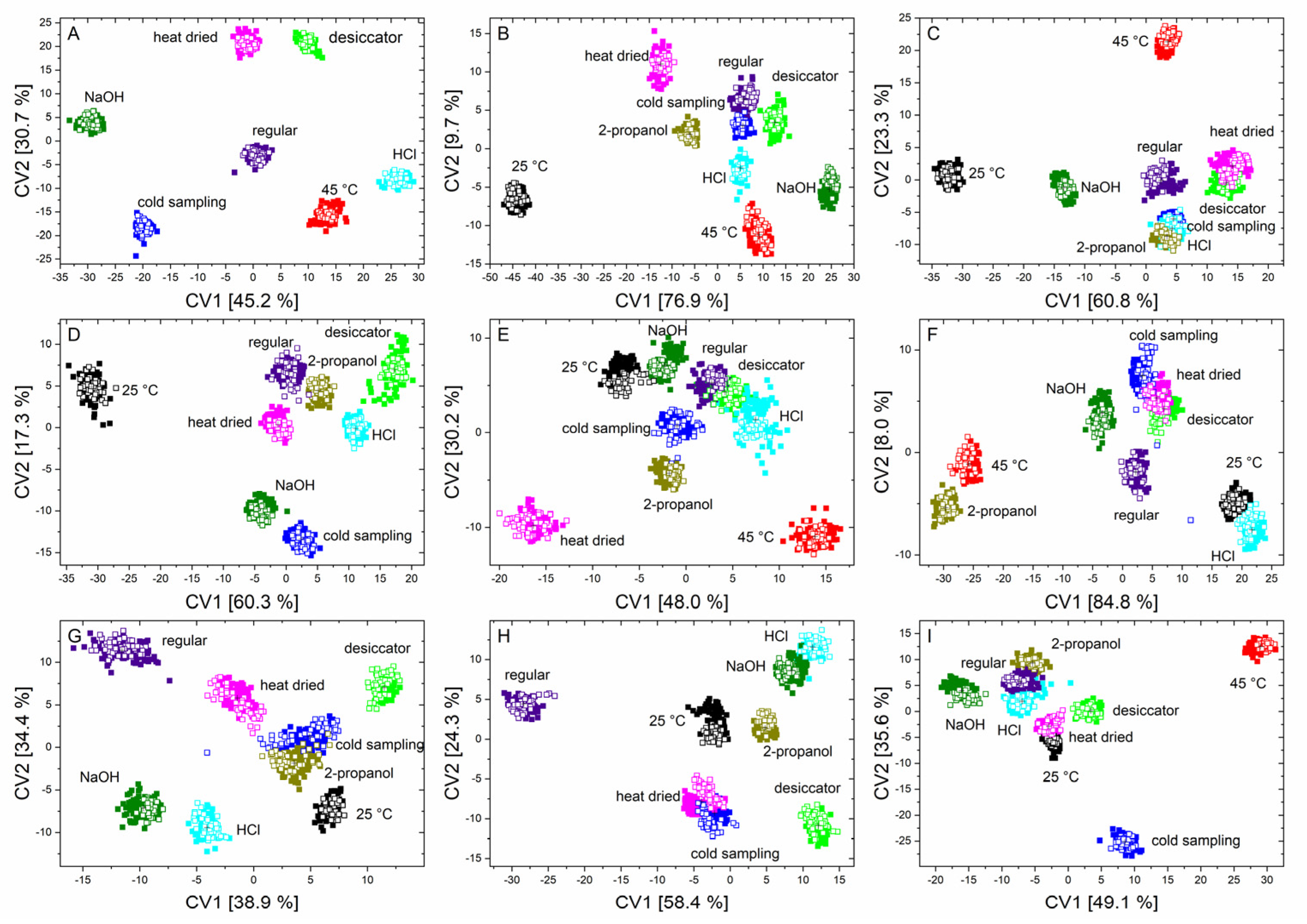Investigation and Rapid Discrimination of Food-Related Bacteria under Stress Treatments Using IR Microspectroscopy
Abstract
1. Introduction
2. Materials and Methods
2.1. Bacterial Cultures and Sample Preparation
2.2. Sample Treatment
2.2.1. Reference Samples (Regular Treatment)
2.2.2. Incubation under Acidic Conditions
2.2.3. Incubation under Alkaline Conditions
2.2.4. Incubation at Lower/Higher Temperatures
2.2.5. Incubation with 2-Propanol
2.2.6. Cold Sampling
2.2.7. Heat-Drying
2.2.8. Desiccation
2.3. Instrumentation
2.4. Data Handling and Visualization
3. Results and Discussion
3.1. Bacteria Prediction Model
3.2. Stress Condition Prediction Model
4. Conclusions
Supplementary Materials
Author Contributions
Funding
Institutional Review Board Statement
Informed Consent Statement
Data Availability Statement
Conflicts of Interest
References
- Candoğan, K.; Altuntas, E.G.; İğci, N. Authentication and Quality Assessment of Meat Products by Fourier-Transform Infrared (FTIR) Spectroscopy. Food Eng. Rev. 2020, 13, 66–91. [Google Scholar] [CrossRef]
- Alvarez-Ordóñez, A.; Mouwen, D.J.M.; López, M.; Prieto, M. Fourier transform infrared spectroscopy as a tool to characterize molecular composition and stress response in foodborne pathogenic bacteria. J. Microbiol. Methods 2011, 84, 369–378. [Google Scholar] [CrossRef]
- Oliver, J.D. The viable but nonculturable state in bacteria. J. Microbiol. 2005, 43, 93–100. [Google Scholar]
- Price, P.B.; Sowers, T. Temperature dependence of metabolic rates for microbial growth, maintenance, and survival. Proc. Natl. Acad. Sci. USA 2004, 101, 4631–4636. [Google Scholar] [CrossRef]
- Marles-Wright, J.; Lewis, R.J. Stress responses of bacteria. Curr. Opin. Struct. Biol. 2007, 17, 755–760. [Google Scholar] [CrossRef]
- Ajaykumar, V.J.; Mandal, P.K. Modern concept and detection of spoilage in meat and meat products. In Meat Quality Analysis; Elsevier: Amsterdam, The Netherlands, 2020; pp. 335–349. ISBN 9780128192337. [Google Scholar]
- Gurbanov, R.; Gozen, A.G.; Severcan, F. Rapid classification of heavy metal-exposed freshwater bacteria by infrared spectroscopy coupled with chemometrics using supervised method. Spectrochim. Acta Part A Mol. Biomol. Spectrosc. 2018, 189, 282–290. [Google Scholar] [CrossRef]
- Teng, L.; Wang, X.; Wang, X.; Gou, H.; Ren, L.; Wang, T.; Wang, Y.; Ji, Y.; Huang, W.E.; Xu, J. Label-free, rapid and quantitative phenotyping of stress response in E. coli via ramanome. Sci. Rep. 2016, 6, 34359. [Google Scholar] [CrossRef]
- Lu, X.; Al-qadiri, H.M.; Lin, M.; Rasco, B.A. Application of Mid-infrared and Raman Spectroscopy to the Study of Bacteria. Food Bioprocess Technol. 2011, 4, 919–935. [Google Scholar] [CrossRef]
- Davis, R.; Mauer, L. Fourier transform infrared (FT-IR) spectroscopy: A rapid tool for detection and analysis of foodborne pathogenic bacteria. Curr. Res. Technol. Educ. Top. Appl. Microbiol. Microb. Biotechnol. 2010, 2, 1582–1594. [Google Scholar]
- Bozoglu, F.; Alpas, H.; Kaletunc, G. Injury recovery of foodborne pathogens in high hydrostatic pressure treated milk during storage. FEMS Immunol. Med. Microbiol. 2004, 40, 243–247. [Google Scholar] [CrossRef]
- Klein, D.; Breuch, R.; Reinmüller, J.; Engelhard, C.; Kaul, P. Rapid detection and discrimination of food-related bacteria using IR-microspectroscopy in combination with multivariate statistical analysis. Talanta 2021, 232, 122424. [Google Scholar] [CrossRef]
- Helm, D.; Labischinski, H.; Naumann, D. Elaboration of a procedure for identification of bacteria using Fourier-Transform IR spectral libraries: A stepwise correlation approach. J. Microbiol. Methods 1991, 14, 127–142. [Google Scholar] [CrossRef]
- Breuch, R.; Klein, D.; Siefke, E.; Hebel, M.; Herbert, U.; Wickleder, C.; Kaul, P. Differentiation of meat-related microorganisms using paper-based surface-enhanced Raman spectroscopy combined with multivariate statistical analysis. Talanta 2020, 219, 121315. [Google Scholar] [CrossRef]
- Ami, D.; Natalello, A.; Schultz, T.; Gatti-Lafranconi, P.; Lotti, M.; Doglia, S.M.; de Marco, A. Effects of recombinant protein misfolding and aggregation on bacterial membranes. Biochim. Biophys. Acta Proteins Proteom. 2009, 1794, 263–269. [Google Scholar] [CrossRef]
- Scherber, C.M.; Schottel, J.L.; Aksan, A. Membrane phase behavior of Escherichia coli during desiccation, rehydration, and growth recovery. Biochim. Biophys. Acta Biomembr. 2009, 1788, 2427–2435. [Google Scholar] [CrossRef]
- Beney, L.; Mille, Y.; Gervais, P. Death of Escherichia coli during rapid and severe dehydration is related to lipid phase transition. Appl. Microbiol. Biotechnol. 2004, 65, 457–464. [Google Scholar] [CrossRef]
- Lin, M.; Al-Holy, M.; Al-Qadiri, H.; Kang, D.-H.; Cavinato, A.G.; Huang, Y.; Rasco, B.A. Discrimination of Intact and Injured Listeria monocytogenes by Fourier Transform Infrared Spectroscopy and Principal Component Analysis. J. Agric. Food Chem. 2004, 52, 5769–5772. [Google Scholar] [CrossRef]
- Saulou, C.; Jamme, F.; Girbal, L.; Maranges, C.; Fourquaux, I.; Cocaign-Bousquet, M.; Dumas, P.; Mercier-Bonin, M. Synchrotron FTIR microspectroscopy of Escherichia coli at single-cell scale under silver-induced stress conditions. Anal. Bioanal. Chem. 2013, 405, 2685–2697. [Google Scholar] [CrossRef]
- Liu, Y.; He, L.; Mustapha, A.; Li, H.; Hu, Z.Q.; Lin, M. Antibacterial activities of zinc oxide nanoparticles against Escherichia coli O157:H7. J. Appl. Microbiol. 2009, 107, 1193–1201. [Google Scholar] [CrossRef]
- Kepenek, E.S.; Severcan, M.; Gozen, A.G.; Severcan, F. Discrimination of heavy metal acclimated environmental strains by chemometric analysis of FTIR spectra. Ecotoxicol. Environ. Saf. 2020, 202, 110953. [Google Scholar] [CrossRef] [PubMed]
- Kepenek, E.S.; Gozen, A.G.; Severcan, F. Molecular characterization of acutely and gradually heavy metal acclimated aquatic bacteria by FTIR spectroscopy. J. Biophotonics 2019, 12, 1–10. [Google Scholar] [CrossRef] [PubMed]
- Al-Qadiri, H.M.; Lin, M.; Al-Holy, M.A.; Cavinato, A.G.; Rasco, B.A. Detection of Sublethal Thermal Injury in Salmonella enterica Serotype Typhimurium and Listeria monocytogenes Using Fourier Transform Infrared (FT-IR) Spectroscopy (4000 to 600 cm−1). J. Food Sci. 2008, 73, M54–M61. [Google Scholar] [CrossRef]
- Kilimann, K.V.; Doster, W.; Vogel, R.F.; Hartmann, C.; Gänzle, M.G. Protection by sucrose against heat-induced lethal and sublethal injury of Lactococcus lactis: An FT-IR study. Biochim. Biophys. Acta Proteins Proteom. 2006, 1764, 1188–1197. [Google Scholar] [CrossRef]
- Moen, B.; Janbu, A.O.; Langsrud, S.; Langsrud, Ø.; Hobman, J.L.; Constantinidou, C.; Kohler, A.; Rudi, K. Global responses of Escherichia coli to adverse conditions determined by microarrays and FT-IR spectroscopy. Can. J. Microbiol. 2009, 55, 714–728. [Google Scholar] [CrossRef] [PubMed]
- Lu, X.; Liu, Q.; Wu, D.; Al-Qadiri, H.M.; Al-Alami, N.I.; Kang, D.-H.; Shin, J.-H.; Tang, J.; Jabal, J.M.F.; Aston, E.D.; et al. Using of infrared spectroscopy to study the survival and injury of Escherichia coli O157:H7, Campylobacter jejuni and Pseudomonas aeruginosa under cold stress in low nutrient media. Food Microbiol. 2011, 28, 537–546. [Google Scholar] [CrossRef]
- Hlaing, M.M.; Wood, B.R.; McNaughton, D.; Rood, J.I.; Fox, E.M.; Augustin, M.A. Vibrational spectroscopy combined with transcriptomic analysis for investigation of bacterial responses towards acid stress. Appl. Microbiol. Biotechnol. 2018, 102, 333–343. [Google Scholar] [CrossRef]
- Papadimitriou, K.; Boutou, E.; Zoumpopoulou, G.; Tarantilis, P.A.; Polissiou, M.; Vorgias, C.E.; Tsakalidou, E. RNA Arbitrarily Primed PCR and Fourier Transform Infrared Spectroscopy Reveal Plasticity in the Acid Tolerance Response of Streptococcus macedonicus. Appl. Environ. Microbiol. 2008, 74, 6068–6076. [Google Scholar] [CrossRef] [PubMed]
- Stanborough, T.; Fegan, N.; Powell, S.M.; Tamplin, M.; Chandry, P.S. Insight into the Genome of Brochothrix thermosphacta, a Problematic Meat Spoilage Bacterium. Appl. Environ. Microbiol. 2017, 83, 1–20. [Google Scholar] [CrossRef]
- Mallidis, C.G.; Frantzeskakis, P.; Balatsouras, G.; Katsaboxakis, C. Thermal treatment of aseptically processed tomato paste. Int. J. Food Sci. Technol. 2007, 25, 442–448. [Google Scholar] [CrossRef]
- Lucas, R.; Grande, M.J.; Abriouel, H.; Maqueda, M.; Ben Omar, N.; Valdivia, E.; Martínez-Cañamero, M.; Gálvez, A. Application of the broad-spectrum bacteriocin enterocin AS-48 to inhibit Bacillus coagulans in canned fruit and vegetable foods. Food Chem. Toxicol. 2006, 44, 1774–1781. [Google Scholar] [CrossRef]
- Apetroaie-Constantin, C.; Mikkola, R.; Andersson, M.A.; Teplova, V.; Suominen, I.; Johansson, T.; Salkinoja-Salonen, M. Bacillus subtilis and B. mojavensis strains connected to food poisoning produce the heat stable toxin amylosin. J. Appl. Microbiol. 2009, 106, 1976–1985. [Google Scholar] [CrossRef]
- Vilar, I.; Garcia Fontan, M.C.; Prieto, B.; Tornadijo, M.E.; Carballo, J. A survey on the microbiological changes during the manufacture of dry-cured lacon, a Spanish traditional meat product. J. Appl. Microbiol. 2000, 89, 1018–1026. [Google Scholar] [CrossRef]
- Rosenquist, H.; Smidt, L.; Andersen, S.R.; Jensen, G.B.; Wilcks, A. Occurrence and significance of Bacillus cereus and Bacillus thuringiensis in ready-to-eat food. FEMS Microbiol. Lett. 2005, 250, 129–136. [Google Scholar] [CrossRef]
- Gospavic, R.; Kreyenschmidt, J.; Bruckner, S.; Popov, V.; Haque, N. Mathematical modelling for predicting the growth of Pseudomonas spp. in poultry under variable temperature conditions. Int. J. Food Microbiol. 2008, 127, 290–297. [Google Scholar] [CrossRef]
- Herbert, U. Assessment of Different Packaging Atmospheres for the Poultry Meat Industry Based on an Overall Quality Index. Ph.D. Thesis, Rheinische Friedrich-Wilhelms-Universität Bonn, Bonn, Germany, 2014. [Google Scholar]
- Leibniz Institut, D. Leibniz Institute DSMZ-German Collection of Microorganisms and Cell Cultures, Catalogue of Microorganisms. Available online: https://www.dsmz.de/catalogues/catalogue-microorganisms.html (accessed on 28 September 2020).
- Klein, D.; Breuch, R.; von der Mark, S.; Wickleder, C.; Kaul, P. Detection of spoilage associated bacteria using Raman-microspectroscopy combined with multivariate statistical analysis. Talanta 2019, 196, 325–328. [Google Scholar] [CrossRef]
- Sabbatini, S.; Conti, C.; Orilisi, G.; Giorgini, E. Infrared spectroscopy as a new tool for studying single living cells: Is there a niche? Biomed. Spectrosc. Imaging 2017, 6, 85–99. [Google Scholar] [CrossRef]
- Naumann, D. Infrared Spectroscopy in Microbiology. In Encyclopedia of Analytical Chemistry; John Wiley & Sons, Ltd.: Chichester, UK, 2006; pp. 1–29. ISBN 9780470027318. [Google Scholar]
- Janbu, A.O.; Møretrø, T.; Bertrand, D.; Kohler, A. FT-IR microspectroscopy: A promising method for the rapid identification of Listeria species. FEMS Microbiol. Lett. 2008, 278, 164–170. [Google Scholar] [CrossRef] [PubMed][Green Version]
- Xie, J.; Qiu, Z. The effect of imbalanced data sets on LDA: A theoretical and empirical analysis. Pattern Recognit. 2007, 40, 557–562. [Google Scholar] [CrossRef]
- Burgos-Paz, W.; Ramos-Onsins, S.E.; Pérez-Enciso, M.; Ferretti, L. Correcting For Unequal Sampling in Principal Component Analysis of Genetic Data. In Proceedings of the 10th World Congress of Genetics Applied to Livestock Production, Vancouver, BC, Cananda, 19 August 2014; pp. 1–3. [Google Scholar]
- Moore, D.H. Combining linear and quadratic discriminants. Comput. Biomed. Res. 1973, 6, 422–429. [Google Scholar] [CrossRef]
- Fulcomer, M.C.; Schönemann, P.H.; Molnar, G. Classification by linear and quadratic discriminant scores. Behav. Res. Methods Instrum. 1974, 6, 443–445. [Google Scholar] [CrossRef]
- Wu, W.; Mallet, Y.; Walczak, B.; Penninckx, W.; Massart, D.L.; Heuerding, S.; Erni, F. Comparison of regularized discriminant analysis linear discriminant analysis and quadratic discriminant analysis applied to NIR data. Anal. Chim. Acta 1996, 329, 257–265. [Google Scholar] [CrossRef]
- Grewal, M.K.; Jaiswal, P.; Jha, S.N. Detection of poultry meat specific bacteria using FTIR spectroscopy and chemometrics. J. Food Sci. Technol. 2015, 52, 3859–3869. [Google Scholar] [CrossRef]
- Rebuffo-Scheer, C.A.; Dietrich, J.; Wenning, M.; Scherer, S. Identification of five Listeria species based on infrared spectra (FTIR) using macrosamples is superior to a microsample approach. Anal. Bioanal. Chem. 2008, 390, 1629–1635. [Google Scholar] [CrossRef]
- Campos, J.; Sousa, C.; Mourão, J.; Lopes, J.; Antunes, P.; Peixe, L. Discrimination of non-typhoid Salmonella serogroups and serotypes by Fourier Transform Infrared Spectroscopy: A comprehensive analysis. Int. J. Food Microbiol. 2018, 285, 34–41. [Google Scholar] [CrossRef]
- Wenning, M.; Büchl, N.R.; Scherer, S. Species and strain identification of lactic acid bacteria using FTIR spectroscopy and artificial neural networks. J. Biophotonics 2010, 3, 493–505. [Google Scholar] [CrossRef] [PubMed]
- Loffhagen, N.; Härtig, C.; Geyer, W.; Voyevoda, M.; Harms, H. Competition betweencis, trans and Cyclopropane Fatty Acid Formation and its Impact on Membrane Fluidity. Eng. Life Sci. 2007, 7, 67–74. [Google Scholar] [CrossRef]




| Class | Training Data | Test Data | Training Data [%] |
|---|---|---|---|
| B. coag | 1050 | 350 | 75.0 |
| B. sub | 1050 | 750 | 58.3 |
| B. therm | 1050 | 750 | 58.3 |
| B. tii | 1050 | 550 | 65.6 |
| E. coli K12 | 1050 | 750 | 58.3 |
| M. luteus | 1050 | 750 | 58.3 |
| Ps. fluor 4358 | 1050 | 550 | 65.6 |
| Ps. fluor 50090 | 1050 | 550 | 65.6 |
| E. coli TOP10 | 1050 | 750 | 58.3 |
| Predicted Class | |||||||||
|---|---|---|---|---|---|---|---|---|---|
| Class | B. coag | B. sub | B. therm | B. tii | E. coli K12 | E. coli TOP10 | Ps. fluor 4358 | Ps. fluor 50090 | M. luteus |
| B. coag | 349 | 1 | 0 | 0 | 0 | 0 | 0 | 0 | 0 |
| B. sub | 0 | 750 | 0 | 0 | 0 | 0 | 0 | 0 | 0 |
| B. therm | 0 | 0 | 750 | 0 | 0 | 0 | 0 | 0 | 0 |
| B. tii | 0 | 0 | 0 | 550 | 0 | 0 | 0 | 0 | 0 |
| E. coli K12 | 0 | 0 | 0 | 0 | 601 | 99 | 0 | 50 | 0 |
| E. coli TOP10 | 0 | 0 | 0 | 0 | 10 | 740 | 0 | 0 | 0 |
| Ps. fluor 4358 | 0 | 0 | 0 | 0 | 1 | 11 | 514 | 24 | 0 |
| Ps. fluor 50090 | 0 | 0 | 0 | 0 | 0 | 0 | 0 | 550 | 0 |
| M. luteus | 0 | 0 | 0 | 0 | 0 | 0 | 0 | 0 | 750 |
| Error Distribution | B. sub | E. coli K12 | E. coli TOP10 | Ps. fluor 50090 |
|---|---|---|---|---|
| B. coag-HCl | 1 | -- | -- | -- |
| E. coli K12-heat dried | -- | -- | 49 | -- |
| E. coli K12-2-propanol | -- | -- | -- | 50 |
| E. coli K12-regular | -- | -- | 50 | -- |
| E. coli TOP10-heat dried | -- | 1 | -- | -- |
| E. coli TOP10-regular | -- | 9 | -- | -- |
| Ps. fluor 4358-cold sampling | -- | -- | 8 | -- |
| Ps. fluor 4358-2-propanol | -- | -- | 3 | 24 |
| Ps. fluor 4358-NaOH | -- | 1 | -- | -- |
Publisher’s Note: MDPI stays neutral with regard to jurisdictional claims in published maps and institutional affiliations. |
© 2021 by the authors. Licensee MDPI, Basel, Switzerland. This article is an open access article distributed under the terms and conditions of the Creative Commons Attribution (CC BY) license (https://creativecommons.org/licenses/by/4.0/).
Share and Cite
Klein, D.; Breuch, R.; Reinmüller, J.; Engelhard, C.; Kaul, P. Investigation and Rapid Discrimination of Food-Related Bacteria under Stress Treatments Using IR Microspectroscopy. Foods 2021, 10, 1850. https://doi.org/10.3390/foods10081850
Klein D, Breuch R, Reinmüller J, Engelhard C, Kaul P. Investigation and Rapid Discrimination of Food-Related Bacteria under Stress Treatments Using IR Microspectroscopy. Foods. 2021; 10(8):1850. https://doi.org/10.3390/foods10081850
Chicago/Turabian StyleKlein, Daniel, René Breuch, Jessica Reinmüller, Carsten Engelhard, and Peter Kaul. 2021. "Investigation and Rapid Discrimination of Food-Related Bacteria under Stress Treatments Using IR Microspectroscopy" Foods 10, no. 8: 1850. https://doi.org/10.3390/foods10081850
APA StyleKlein, D., Breuch, R., Reinmüller, J., Engelhard, C., & Kaul, P. (2021). Investigation and Rapid Discrimination of Food-Related Bacteria under Stress Treatments Using IR Microspectroscopy. Foods, 10(8), 1850. https://doi.org/10.3390/foods10081850







